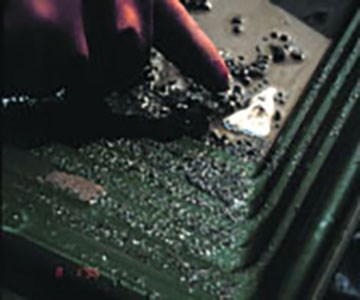Last updated: October 23, 2021
Article
Mining and Mitigation: The Coal Creek Remediation Project
By Linda Stromquist

National Park Service photograph by Linda Stromquist
As a result, 830 55-gallon drums, 18 lead-acid batteries, 2,500 pounds of solid waste, and 46,000 pounds of scrap steel were removed from the area in 1994. By 1996, park managers initiated an effort to remediate lead-and mercury-contaminated soils in the watershed. NPS crews excavated approximately five cubic yards of lead-contaminated soils from the historic blacksmith shop. This material was packed into drums and shipped for disposal to a licensed facility in Washington State.
For the mercury-contaminated soils, a different process was followed. NPS crews built an on-site soil washing facility to treat the contaminated soils. A 4,000 square foot work pad and 14,000 gallon recycle pond were constructed in the maintenance yard of the main camp complex. Approximately 45 cubic yards of mercury-contaminated soil were excavated from the area surrounding the historic assay building and transported to the work pad. The soils were then mixed in a slurry, treated with an ore cleaning solution, and passed across a hydraulic jig, a copper plate, and a series of sluice boxes. Process waters were directed into the recycle pond and process solids were retained on the work pad until laboratoryanalysis verified cleanup standards had been obtained. An on-site lab utilized X-ray fluorescence analysis to monitor excavation and soil washing operations. Northern Testing Laboratory in Fairbanks also analyzed samples, confirming the on-site findings. Approximately 172 pounds of mercury concentrates generated by the soil washing effort were shipped off-site for disposal.
The NPS continued environmental miti-gation of Coal Creek camp with a detailed investigation of petroleum-contaminated soil in and around the Coal Creek area. After excavation of the petroleum-contaminated soils, the material was treated by thermal desorption, utilizing a portable thermal treatment unit that was flown to the site in the summer of 1998. With the close of the field season in 1998, the NPS completed the multi-year remediation of the contaminants that were part of the legacy of mining in the Coal Creek valley.
